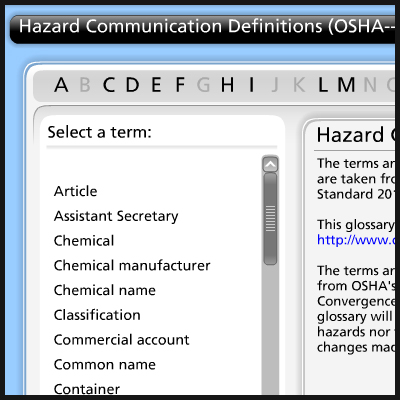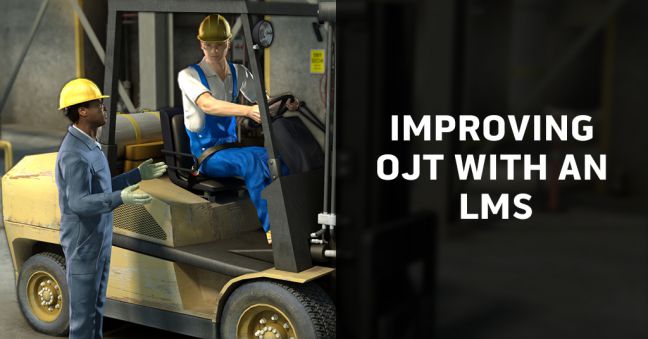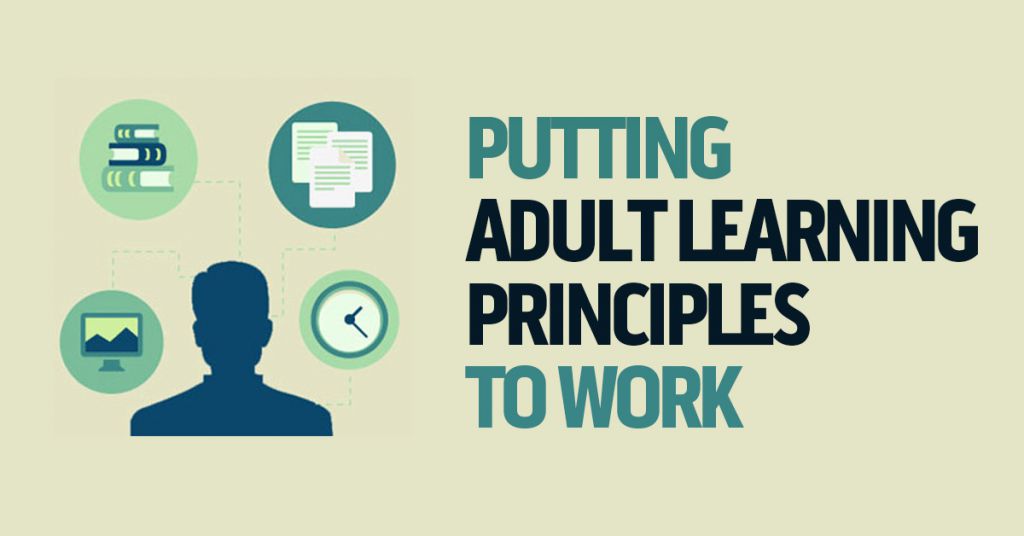
Below is an interactive glossary including all of the terms OSHA has defined in their Hazard Communication 2012 Standard, which aligns the HazCom Standard with the Globally Harmonized System (GHS).

Note: An earlier blog post gave some tips for setting up effective on-the-job training (OJT) programs at work. It’s not necessary to read that post before reading this one, but if you want to, it’s there for you.
If you’re giving some thought to the best ways to implement an OJT program at work, you’re already making some good initial steps. But have you thought about how your OJT program could benefit if you use it in combination with a learning management system (LMS)?
In this article, we’ll take a look.

We recently wrote a post to help you comply with the new labeling requirements mandated by the Hazard Communication/HazCom 2012 alignment with the Globally Harmonized System (GHS).
There are several hazards that aren’t covered by the new labels. Hazards like pyrophoric gases, simple asphyxiants, and combustible dusts have their own unique requirements. Others have been grouped together and labeled as “Hazards Not Otherwise Classified.” In this post, we’re going to talk specifically about the requirements for pyrophoric gasses, simple asphixiants, and combustible dusts.
We recently wrote a post to help you comply with the new labeling requirements mandated by the Hazard Communication/HazCom 2012 alignment with the Globally Harmonized System (GHS). If you missed that post, you can read it here.
In this post, we’re going to give some information on what OSHA calls “hazards not otherwise classified,” or HNOC.
In addition, you may want to read our other post addressing HazCom requirements for pyrophoric gases, simple asphyxiants, and combustible dusts.
Almost every workplace does some form of on-the-job training (OJT). In many cases, especially at companies in manufacturing or industrial industries, a good deal of that OJT training occurs when an inexperienced worker follows a more experienced worker around on the job. This is often called “shadowing” or “following.”
The results from OJT training involving shadowing can be mixed at best. In some cases, job knowledge is transferred effectively, and the less-experienced worker ends up being able to perform all of the necessary job tasks. In other cases, though, things don’t go so well, and workers are left without the knowledge, skills, and abilities necessary to succeed at their jobs.
Obviously, companies can’t afford to have OJT programs that don’t effectively train their employees. Plus, it puts the employee being trained in an unnecessarily difficult spot. But what can be done?
Below are some tips to get your OJT programs headed in the right direction. They’re not the full story, but they’ll get you moving forward and making progress.
We’re excited to announce that we’ll soon release our Corrugated Box Basics computer-based training module. What’s even more exciting is that Corrugated Box Basics is the first of an 8-module CBT library called Box Plant Basics that we’ve currently got in production; additional titles will be released shortly.
The Box Plant Basics course offerings will serve as a comprehensive introduction to the process of making corrugated boxes. Box plants can use it to:
The Box Plant Basics library will include eight modules covering the process from A to Z. The modules are:
Of course, these new computer-based training courses have all the features you’ve come to expect from your friends at Convergence Training. These include:
We’ll make an announcement when the Corrugated Box Basics course is finished—that should be very soon. And we’ll make additional announcements when the other courses in this library become available. Keep your eyes on your inbox, the Convergence Training blog, and the full list of training courses we offer on our website to keep up to date.

If you’ve studied different ways to make the training at your work place better, you’ve probably noticed a few things. The first is that a lot of the ideas are presented in difficult, specialized language that you wouldn’t hear at the water cooler. And the second is that it’s not always clear how to put these different ideas to work. And hey, to expand that, maybe you’ve noticed that employees often don’t remember or apply the training on the job.
Let’s see if we can help you with those problems so you can make your job-training programs better. Specifically, we’ll list and define six adult learning principles and give you some tips on how to put them to work in your training.
Understanding adult learning principles will help you create training materials and a training program that helps adults learn. Without this understanding, your training program won’t be as effective.
Once you’ve got these adult learning principles down and know how to use them while designing, developing, and delivering training, there’s more to learn and do. But this is certainly a great place to start.
By now, you’ve probably heard that the new HazCom 2012 standard has been revised to align with the Globally Harmonized System, or GHS. If we just caught you 100% unaware, you are now excused to go read the information on OSHA’s website about the GHS alignment.
However, we suspect most of you know about this, but that you have been wondering just exactly what it means. Or maybe you’ve wondered about a few of the details. If so, the following is for you. (more…)
![]()
We’ve been updating our Online Hazard Communication training to include the new Globally Harmonized System (GHS) label standards. The official GHS pictograms are out there on the internet in a few places, but we weren’t able to find all nine of the major symbols in a single file. Not for free, anyway. So, we cobbled all the symbols together in vector format to make it easier on us as we make our updates, and we thought it’d be nice to make it available for others to use for their GHS-labelling needs.

We’re preparing for the upcoming release of Convergence Mobile, our tablet-based mobile training solution. Designed to integrate seamlessly with our Convergence Learning Management System (LMS), Convergence Mobile is an essential on-the-job training tool.
Convergence Mobile puts information in the hands of workers in the field, leading to decreased downtime and production expenses, and makes it easier to train workers in their work environment, which cuts the cost of training while at the same time making it more effective.
If you’re Convergence LMS user, you’ll soon be able to add this fully-integrated mobile component to your training program. And if you’re not yet a Convergence customer, the addition of Convergence Mobile to the powerful features in Convergence LMS should open your eyes to a whole new world of training opportunities.
Work Performance Support Delivery: Use the tablet’s built-in barcode scanner to view a list of any training activity or reference material related to a machine or work area and then view that material instantly. Get access to the information you need when you need it most—on the job.
On-the-Job Training (OJT) Skill Demonstrations and Approvals: With Convergence Mobile’s Instructor Tools, a supervisor can give credit to an employee for properly demonstrating skills, procedures, or knowledge in the field. The supervisor can check the employee after each item is completed, and both the employee and supervisor can sign a digital document to confirm the training is complete. Training data is automatically synched with other employee training records in Convergence LMS.
Fully Automated Training Verification: Create training activities that ask employees to identify machines, machine components, or work areas. Then let the employee take the Convergence Mobile tablet in the field and use the built-in barcode scanner to complete the identifications. Let Mobile save your money by freeing up supervisors for more important jobs.
Full PC Functionality: Convergence Mobile isn’t just a learning device; it provides you with a modern, wi-fi-enabled, touch-screen PC running Windows 7. If you can do it on a laptop, you can do it on a tablet. Send emails, write notes, update spreadsheets, and surf the internet.
Flexible Hardware Options: Convergence Mobile can run on any Windows-based tablet. From rugged, shock-proof workhorses, to slim, lightweight portables, run Mobile on the hardware most appropriate for the job.
Convergence Mobile will begin to be available to current Convergence LMS users beginning in December 2012, with a full release date planned for early 2013. Stay tuned for updates.
We’re making the final preparations for the release of our Violence in the Workplace course. This will be the second title from our new Workforce Essentials library of DVD and CBT training courses, adding to our Sexual Harassment Awareness course, currently available from BuyBetterTraining.com.
Perfect for management and human resources departments, our Workforce Essentials library contains courses relevant to establishing fundamental guidelines for safe, healthy, and respectful employee conduct. We’re planning to add 16 new courses to the library over the coming year.
Of course, these new courses will be loaded with all the features you’ve come to expect from Convergence training, such as:
Be sure to check back to see when the courses in this exciting and highly useful new training library are available. On our end, we’ll be sure to make an announcement as each of these courses becomes available for sale.
When I’m not at work, I read a lot of stuff directly related to my work. This includes lots of books on instructional design, training, learning and development, and performance improvement. And it includes books on safety and safety management. And on manufacturing, maintenance, and reliability.
Sometimes, though, I like to kick back and read something different. I even retreat into the pure escapism of a novel sometime (most recent novel, as of October 31, 2018: The Song of Achilles). But ignoring the occasional novel, even if a book I’m reading isn’t directly related to my work, it’s often indirectly related. And that’s the case with a book I just finished: Better: A Surgeon’s Notes on Performance, by Atul Gawande.